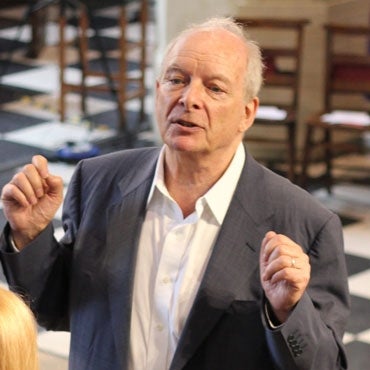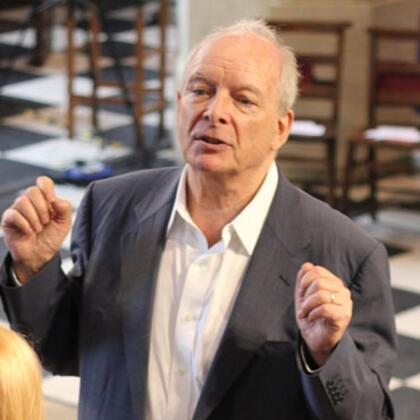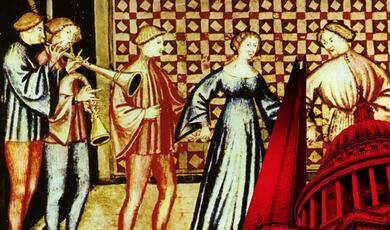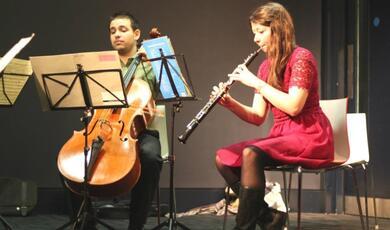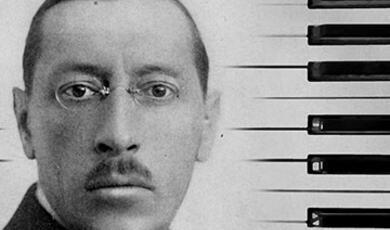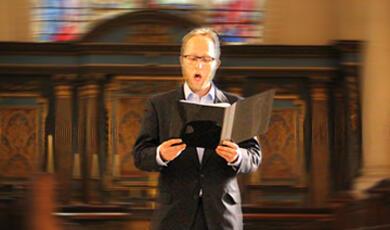11 October 2013
In Prison Camp:
Messiaen 'Quatuor pour la Fin du Temps'
Professor Christpher Hogwood CBE
Good afternoon. Welcome to our series in this new building. It is known as the musicians’ church. If anybody is interested, you can find Henry Wood’s ashes, and many other musical monuments in this side chapel, very much used for concerts now, and I am very familiar with this building from rehearsals. So, it is London’s musicians’ church, and therefore a different style of architecture from the style we were familiar with last year, in Spitalfields, but equally appropriate to the business of music.
I should just say a word about the complete programme of the year because I wanted to invent a new letter of the alphabet – I wanted to have a letter than was an “N” with an extra cross piece in it, a double letter which does not exist, so that you could have both “content” and “context” because there is very little chance in music of getting away, in practical terms, from the business of the context of music and the content of music. Academically, you might be able to defend it; in practical terms, the two are very bound up, so it came out, in the end, as “Music in Context”. What I will be dealing with in these six lectures is a question both of the setting in which music takes place, or is designed to take place, and also the provocation that makes the music happen in the first place – that is its reason for existing and also the place in which it happens to exist.
Not all music has an abstract purpose, of course. We tend to glorify music as being the art which is most abstracted from things that pull it down to worldly or verbal levels. There are many reasons for music happening which are not quite as abstract as you might like: there can be music for teaching; you can have music for dancing; you can, as you will find in a later lecture, music for advertising – for filling any blank space, in fact. It can act as a vehicle for virtuosity rather than having any real content. It can also advertise the wealth of the patron, the person who is paying for it, at the creative moment, and of course, you will remember that the Goldberg Variations by Bach were written to fill the sleepless moments of an insomniac employer. So, there are many functions that music can fulfil in addition to it being good music.
I think you can never escape really from the historical facts that music has an origin. That may not be the entire story, but it has to be taken on-board, and we hope that the origin will not be the whole story of the piece, but it is an essential component of its DNA. Sometimes, it can lift itself above the start, as you will find I think with music designed, in the first instance, for advertising, or music designed, in the first place, for being teaching material rather than concert material. I suspect, in the end, when we have done these six different topics that you find listed in your programme, we will conclude that good music can rise above its origins, or its context, and less good music may be better understood in terms of how it originated, so we are all gainers really in this business.
It is possible, of course, to have music which arises from no particular objective and with no great background intention – simply good, pure, simple, abstract music that will come out. That example, I have put at the end of the year’s sequence – it is the Schubert Quintet, which seems to me to have no reason for having been created or for existing, other than it was just wonderful music which had to be written, but lacking any other context – it has purely content.
The remainder of the pieces, I think, in the year, you will see can all be taken out of their first context and set-up in any other, but, nevertheless, they will always carry the hallmark of these origins to some extent, and we will look more deeply into what happens at the originating stage.
You will have realised, after three years of hearing me talking on music, that I am not a great advocate of this sort of “warm bath” approach to music – nice, you know, just lean back, relax and let it wash over you. I suspect you are on my side in this, that I think you want to know more about it. We will try to provide more about it, and also a healthy proportion of live music played by members of the Royal Academy of Music, who will be providing the music in all six of these lectures, and I think the digging into this music and the hearing it played live are the two main facets, I think, of this series.
Notice, just as a warning, that, this year, we are on different days of the week. I am told to remind you that, although it is Friday today, you will see on the list that other lectures happen on Thursdays and one rogue lecture happens on a Wednesday, so please do not come for the Wednesday lecture on a Thursday here or you will find something else going on, although it will quite possibly be musical, as I say, because this is a musicians’ church, much used for the preparation of music.
Our starting point today is Messiaen and the Quartet for the End of Time. I think it would be hard to guess from its title, or from listening to it, if anybody already is familiar with this piece, you would not guess that its origin was a prisoner of war camp, a concentration camp. It may look a shocking way of starting a series, but it certainly points up the business of the context in the starting DNA of this music.
Concentration camp, in most people’s mind, takes you to Terezin, Theresienstadt, the most famous of the camps in the last War, which was set up in what is now the Czech Republic, as a specific place for grouping musicians. It had symphony orchestras, opera companies, a number of composers went there, and never came back from there – so you have names like Schulhoff and Haas and Gideon Klein. That is a well-publicised end of classical music I think, in the wartime regime. The one we are dealing with today is not so extreme, but it could have felt similarly dangerous to the people involved.
This is 1940s France. The Germans have just arrived on the scene. The English have just left the scene, via Dunkirk, and lots of French were moving around trying to get away from the threat of being found in Paris when the Germans arrived. Messiaen was amongst these people. I believe he was 31, and he and thousands of others were trying to clear the capital. In Messiaen’s case, he was found in a wood near Nancy, along with many others, and the wood was surrounded and he was taken away, first to a holding camp, where he found one clarinettist friend of his, and then they were all eventually moved on to a camp called Stalag 8A, which is close to Dresden.
Luckily, it was not as dire as one might have thought. Messiaen was quite lucky. He carried very little with him, but the little he did have with him included a score of the Brandenburg Concertos and a score of music by Berg, so he was not badly supplied, and the situation he found in this Stalag 8A was that the commandant was perfectly agreeable to him being given paper and writing materials and able to compose. At first, there was no piano, and even when there was a piano, it was pretty dire, as I will tell you later, but he had a clarinettist friend, there was a violinist with a violin, and there was a cellist, with three strings on the cello, not four, and they somehow had to bargain for an extra string being found so that this could make something unusual for Messiaen, who does not go in for writing chamber music. Basically, this was enforced by the situation, so very much the context in which this piece started was one of deprivation, and Messiaen was reduced to the four instruments that he had.
He himself said that he composed, “…first of all, to escape from the snow, from the War, from captivity and from myself. The greatest benefit,” he said, “that I drew from it all was that, in the midst of 30,000 prisoners,” – it was a very big holding camp, this – “I was not one.” So, his view of music for the imprisoned is that it sets you free.
He composed the piece, as I say, around the facilities he had – very slight, very poor. He eventually got an upright piano moved in, but he did say, when you put the keys down, many of them did not come up again. This could be a reason that some of the music is extremely slow in this piece, but not in all movements, where it really moves along.
He explains the first concert, where they gathered together 5,000 prisoners, and Messiaen says he was sitting at this upright piano, with many keys not functioning, and his three friends around him. He was dressed, he said, in rags and tags, part of a Czech Army uniform, and he was wearing clogs, and the audience of 5,000, he said, included all classes – “peasants, labourers, intellectuals, career soldiers, medics, priests, etc.” Priests come at the end of the list, but they have an important bearing on this whole concept.
The title is not as clear, I think, in English as it would have been in French – Quatuor pour la Fin du Temps. We call it Quartet for the End of Time, but to a French speaker, it could be the end of time, also it could be end of tempo and measured time – it has more musical references in French than in English.
I find Messiaen’s language quite easy to pull apart and describe, and he found so himself – he wrote acres describing his technique of composing and his particular musical language. What I cannot do, and will not start to do, is try to explain what it is and how it works, but we can show you some examples.
So, musicians, you can gather yourselves up here and we can pull out a few plums from this piece…
This is more the content than the context, but I think Messiaen’s language is something that one can sink oneself in quite happily. His written language is, I have to say, very rich and goes almost completely over my head, but I will give you a few quotes and you can see whether you think his view of his own music in any way answers up to what you feel or hear when you absorb it.
Do you want to do a little tuning…?
[Music plays]
In the first instance, this quartet exists because this is what happened to be there, so it is the absolute starting point of writing this piece, to Messiaen, was not one of choosing a quartet. It is not something, I think, he ever found congenial. There is hardly any chamber music from Messiaen at all. He lived a long life, and died in the ‘90s, but he wrote much church music, organ music, large orchestral music, only one other piece that could really be classified as chamber music, so this was imposed upon him.
The elements of his language, though, he had already worked out well in advance. He had held a position in Paris as an organist. He was a prodigy, both performer and composer. He was intellectual and also of religious fervour that goes a long way beyond what most people dream of, and his imagery for religious experiences blends into a type of description that is very suited to the Book of Revelations. It is beyond most people’s vision. He invented and controlled the forces of musical language in a way that are very particular to him. Although he was a very experienced teacher and had many pupils, not many people adopted the musical language and vocabulary and rules that Messiaen himself laid out for his own composing.
We will take a few spot examples. There is the question of the harmonies that he used. He worked on what he called a modal system, so not normal scales and tonalities that you are accustomed to in classical, and baroque and classical, and early romantic music, wafting away into strings, you would previously have said impressionistic harmonies – Messiaen never did. He always linked them to a very strictly controlled sequence of repeated possibilities, and the sort of chords you get are the sort of chords that the piano first plays in the very first movement of this piece.
[Music plays]
They give you a slightly eerie sense of being neither resolved nor completely unresolved – that is, all of them have a very luscious French quality, they sound nice as individual pieces, but do you really feel that one has to move onto the next chord, and when you have got to the next chord, do you really feel it has got to move on to some chord following, or is it a world in itself?
Just play them again, and let us have lots of time between each one and see whether you think that could be the end or it really insists that another chord has to fulfil it…
[Music plays]
That was it! The language, I find, is very attractive. The chords themselves are very sensual. The obligation to move from one to another, to have harmonic tension and resolution, hardly appears in there at all. You can connect all this, of course, with the idea of the end of time or, better probably, “There shall be no more times,” the Book of Revelations says. When the concept of time has finished, then you cannot have a first chord that has to resolve onto a second chord because each could last an eternity.
That is one element of his harmonic language, and there is a modal element, very complicated, if you want to pursue it. Through his own writings, he will explain to you why notes follow each other in a very preordained and cleverly worked out system, which is as strict as the normal scales and harmonies that we are accustomed to in classical and early romantic music, but in a different language.
Rhythm is another thing where Messiaen throws us slightly. He was very interested in prime numbers, like five, seven, eleven and so on. Five, seven, eleven and other prime numbers are not the numbers you are most familiar with in normal standard classical baroque romantic music. You will be dealing in four or eight, and something that you can march to, and something where the pulse stays on a predictable basis – that is, if the toreador starts singing, [sings], you are pretty sure it is going to go on, one, two, three, four, five, six, seven, eight, and so on, much of the time. There is the feeling that the march of time has already been measured out and you know where the next beat is going to fall and you can march, or dance, or anything else that you use functional music for, with a fair degree of being sure that the thing is not going to suddenly shift its measure.
Messiaen saw no need for this, and one of his ways of freeing up one of the other interpretations at the end of time was an end of measured time, as the French would say, what is the pulse of the piece, and a march can go one-two-three-four, and if we want normally extra notes in our march, we do it by stealing from a long note and inserting it while on the run, so you could one-and-two-and-three-and-four, one-and-a-two-and-a-three-and-a-four. Messiaen, equally simply, but more unusually to our ears, would say, if you wanted this extra note, you just add it in, so you get one-two-and-three-four-and-five-six, and however many, and then he groups his pulses according to his principles of prime numbers and a great interest in Eastern music – Indian Hindu music, the music of the gamelan, Indonesian music - constructs which give a rhythmic shape to things, which is impossible to dance to, I think is the first thing. Could you possibly dance to any movement from this piece? I think you never are quite sure where your feet are going to fall because you reach the end of time and there is no guarantee that time is going to exist in the next bar, and you will stumble, but the requisite number of notes that are needed for his modal system will be there. It is a nice way, in fact, of separating the concept of the rhythmic power of the piece and the melodic power of the piece. Normally, we are used to these two being more or less integrated, with strong beats and strong notes, and melodies fall on requisite beats of the bar. Now, for Messiaen, he can stretch the number of notes in the bar and the length of the bar, exactly as far as he wants it to go, with all the extra notes inserted as extras, not accommodated within this pulse. So, I defy anybody to stand up and dance to this music, or even to beat time successfully to this music! He just adds, I cannot say randomly, but even he admitted that all the tricks he was using, and the rules he had made for the music, were not things you had to carry in your head or expect to hear as the music proceeded – they were explanations of how its DNA had been controlled.
A particular example I think is useful, because it is not a modern example, things that operate on a rhythmic pattern – this was known even to medieval composers. If you take a random formulaic system of beats, say two plus seven plus three plus nine plus two plus four plus something, and they build up, and then you reverse them, so in fact you have a palindrome – you reach the middle of your piece and then, towards the end of the piece, this numerical sequence reverses on itself. Well, of course, you do not know that when you are listening to the piece because music does operate in the march of time. However much Messiaen would like to switch off time, music occurs like this – it does not all occur at one moment. So, how are you to know that the sequence of numbers you are meeting now, even if you heard them, is going to come at you in reverse in four or five minutes’ time? These are constructional things, and he was the first person to say this is not something either players have to be incredibly aware of, and nor should a listener, perhaps at all, be aware of.
One other element that is very strong and begins, I think, in this piece of Messiaen and later becomes a very strong facet in his musical vocabulary, and that is birdsong. He decided that the songs of individual birds, which he catalogued and notated, later, birds, he decided, were the opposite of time. It is a slightly gnomic saying, but he saw that it is true – you cannot beat time to a bird singing. The bird will sing for as long as a symphony orchestra plays, but the symphony orchestra you can measure off in bars and beats, birdsong very rarely, although it is clearly constructed and controlled and, every year, we find people changing our definition of what we used to call “bird-brained” by showing us that the birds actually are much cleverer than we thought they were, and there are amazing mathematical sequences in their birdsong, just the same as in their heads they have the ability to navigate from Scotland to North Africa and back and reach the tree they left last year. That is not a “bird-brain” I think doing that, in the conventional sense.
Messiaen then combines all these things. Let us just listen, shall we, to a little bit of the very first movement of this piece, the Liturgy of Crystal. He has some quite highfaluting descriptions of what is going on in all this, but here is a combination of the elements that we have heard. There is the clarinet, which you are playing, expanded music, it is undanceable, unmeasured music, because of these little notes. The violin is being birdsong at this time. The cello is just supplying icing at this moment, I think, in this. Can you defend it on any other grounds? Very beautiful, harmonic effects music, effects music… And the piano is delivering these modal chords, every one of them very carefully calculated. No one of them, I feel, demanding more explanation, but yet, every time there is a following chord, it feels correct.
[Music plays]
There is absolutely nothing, I think, in that to suggest the context of a prisoner of war camp, so you have content and context, completely divorced there.
There is, of course, in all Messiaen’s descriptions of what he is doing, in all his music, a very strong theological content, and you can see in your programmes, from the titles of the movements in the Quatuor, that almost all of them derive from something or other to do with the Book of Revelations. He said, in the little lecture he gave these prisoners before the first performance in sub-zero temperatures, he says: “I told them, first of all, that this quartet was written for the end of time, not as a play on words about the time of captivity, but for the ending of concepts of past and future – that is, for the beginning of eternity, much mentioned in the titles, and in this, I relied on the magnificent text of the Book of Revelations.”
Well, he was quite selective with his text from the Book of Revelations, but he quotes certain chunks of it: “And I saw another mighty angel come down from Heaven, clothed with a cloud, and the rainbow was upon his head, and his face was as it were the Sun, and his feet as pillars of fire, and his left foot on the Earth, and the angel, which I saw stand upon the sea and upon the Earth, lifted up his hand to Heaven and swore by him that lived forever and ever that there should be time no longer, and in the days of the voice of the seventh angel, when he shall begin to sound, the mystery of God should be finished.” He was selective with what he took from Revelations, but you can see the concept of what is there.
The other thing that he gets quite expansive about in his descriptions of what he had in his mind was the question of colour. Again, I can report this to you and we can note that this is what he felt about it. He said, during his captivity, it was “coloured dreams which gave birth to the chords and rhythms of my Quatuor”, and he writes what amounts to a literary fantasy in itself, explaining the sort of colours that he had in his mind. Here is a little sample. He said: “For me, the first transposition of mode two,” – this was what was underneath those harmonies you first saw – “is defined like this: blue violet rocks, speckled with little grey cubes, cobalt blue, deep Prussian blue, highlighted by a bit of violet purple, gold, red, ruby, and stars of mauve, black and white – blue violet is dominant.” That is already quite a handful of colours!
The thing is, these modes could be just transposed up and down the keyboard – you hear them in different transpositions.
Moving up a semitone, the same mode which I think I, and many people, would just read as being the same sequence of harmonic clusters, comes out as completely different colours. He admits it is totally different, and this time, he says, one semitone higher: “It is gold and silver spirals against a background of brown and ruby red vertical stripes - gold and browns are dominant.”
In the next transposition, a semitone up, you get: “Light green, prairie green foliage with specks of blue, silver and reddish orange – dominant is green” – and so it goes on. It sounds rather like an interior decorating brochure or a fashion house handout, but these are amazing visions that he finds the colours are part of the translated version of what he is writing musically. Maybe some people can hear such chords as such specific colours and also the differences when they transpose. I cannot vouch for it, except that I know I do not, although I do like those strings of descriptions and colours, and I think if you listen to those individual chords and think that, to some people, they consist of all these clusters of colours, then every chord could take on a slightly different refractive colour.
So, that is another of his components. Sometimes, I think, these things that mystics explain to us, sometimes the explanation is more problematic than leaving the original mystic vision unexplained. But, still, it is the world of interconnections I think that makes the fascination in itself.
You have this picture in his mind of given colours, given modes, harmonies, strange, additive rhythms that cannot be danced to – this is the world’s most undanceable music – and this question of “Is it the end of time or just the absence of time?” What Revelations says is “Time shall be no more,” so it is not like you are arriving at the end of the world or the end of your imprisonment – it is just an absence of time.
Birdsong has this view, to Messiaen, and one of the movements in the piece is given entirely to the solo clarinet, which is the Abyss of Birds… This is a purely solo declamation of the ideas of the modes, the pictures of an abyss, maybe – it is hard sometimes to know how picturesquely, figuratively or literally you should interpret the line of the music, but certainly I think, for almost everybody, birdsong is birdsong. It is unmeasurable, it is undanceable, but it is certainly absolutely recognisable.
[Music plays]
You might think that could have been extemporised. It is not totally notated. It has all the double characteristics of the complete range of the clarinet, which is an extraordinary range anyway, for effects of abyss. It has the double character of a clarinet playing and a bird singing. It has a full range of precisely notated, I think – nothing is left to chance though I think. You might not know that.
Now let us go to the sixth movement of the piece – we have to skip for little examples. Here is the Dance of Fury, the seven trumpets, which Messiaen said you should hear gongs and colours of all sorts. The point of this is that all instruments play but there is only one line. The whole thing is, I must say, I think nerve-wracking experiment in synchronising, because one slip and you are dead! It goes fast, and it has these additive rhythms, so there is no way of you measuring the pulse in equal segments, and it really is, it is full of the imagery and the colours that Messiaen had in his head, but, unlike the clarinet solo, this is everybody playing practically all the time and, fingers crossed, totally in unison or octaves.
[Music plays]
Having proved they can operate absolutely as equals, we now go on to them operating entirely in free space and no time…
[Music plays]
© Professor Christopher Hogwood CBE, 2013


 Login
Login
